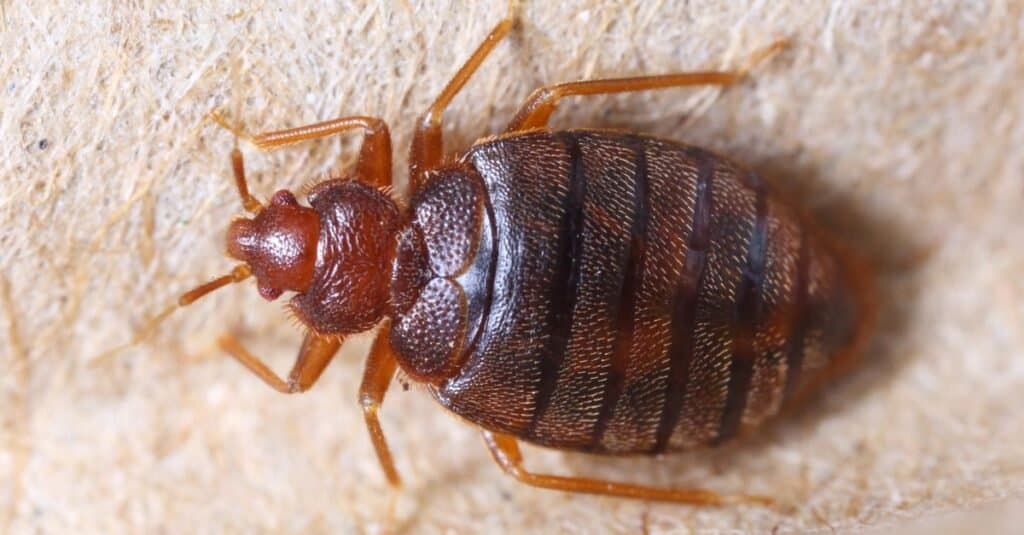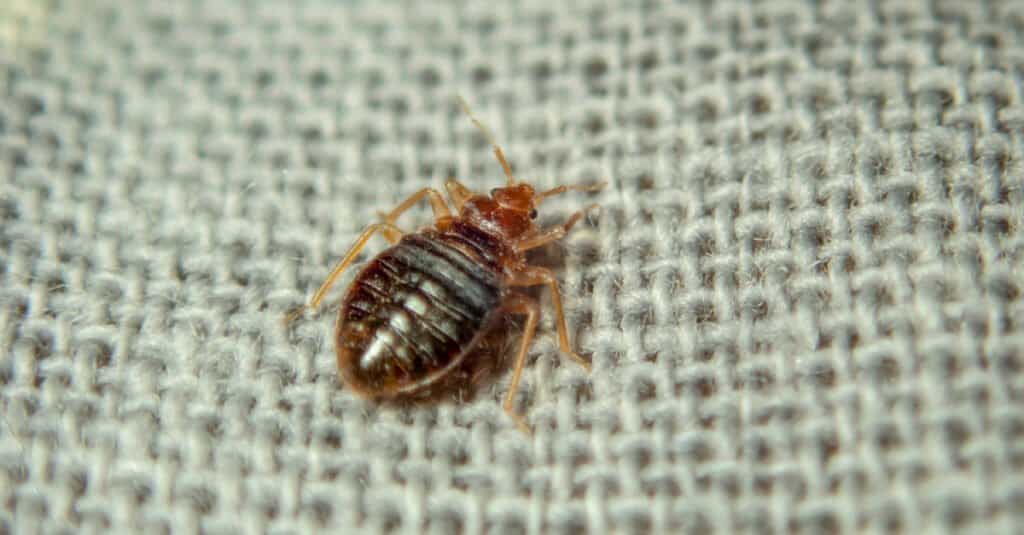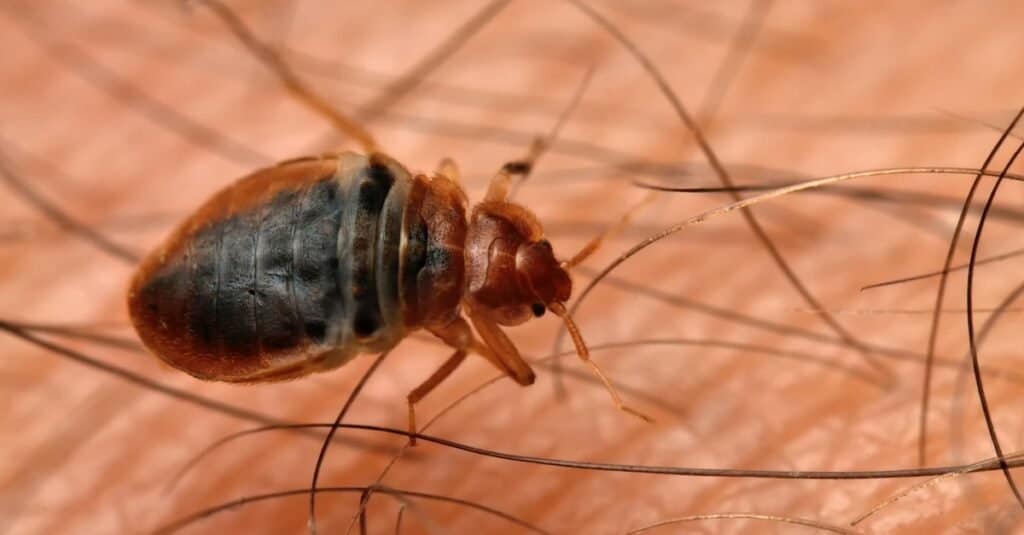Have you ever wondered, are bed bugs nocturnal or diurnal? Do they sleep during the day and feed at night? Or vice versa? There is no simple black-and-white answer regarding bed bug sleep behavior. Although bed bugs primarily exhibit nighttime activity, they may also come out during the day. We explore the sleep behavior of bed bugs and look at their activity cycle. We also discuss some of the implications of their sleep behavior on their ecology. Not sure what ecology means? Simply, it is the link or relationship between living things and their environment. So, let’s get started!
What Are Bed Bugs?

People wonder, are bed bugs nocturnal or diurnal? These blood suckers are primarily nocturnal but can become diurnal if their food depends on it.
©7th Son Studio/Shutterstock.com
Bed bugs are tiny insects that commonly use homes and hotels as a habitat. They are related to other parasitic pests like fleas and lice. However, bed bugs look significantly different from most other kinds of bugs. Unlike many other insects, they do not have wings, so they cannot fly or travel long distances by air. Instead, bed bugs can only move short distances by crawling. Their bodies are oval-shaped and usually about a quarter of an inch long. Bed bugs tend to be reddish brown or tan. However, bed bugs’ appearance can vary depending on how much blood they have recently consumed, which is typically a nocturnal activity.
Bed Bug Sleep Behavior. Are They Nocturnal?
Bed bugs are intriguing creatures with fascinating biology. Studies suggest that bed bugs have periods of nocturnal activity and inactivity that correspond more with one sleep pattern than the other. For instance, bed bugs seem primarily active at night and become more dormant during daylight hours. While there is not much research on bed bugs’ sleep quality, it is apparent that they rest in some form. This behavior suggests that they are more nocturnal than diurnal.
Bed Bug Activity and Feeding Behavior
Several factors influence bed bug activity and feeding behavior. Several of these factors include temperature, humidity, availability of food, and time of year. Understanding how these aspects affect their activity can help eradicate these tiny pests better.
Bed bugs are attracted to body heat and carbon dioxide, so they gravitate toward their favorite spots. These places include bedding or other close quarters to people and animals. Besides, although their sleep habits are unclear, bed bugs are notorious for their nocturnal habits. So, they feed mainly at night when their human or animal hosts are asleep and less likely to disturb them.
However, recent research suggests that bed bugs also come out in the daytime to enjoy their favorite human or animal blood meal. This feeding practice is mainly present in large populations where no viable human or animal hosts are available in their chosen habitat.
Some studies suggest that bed bugs successfully feed during the day up to one-third of the time. Particularly on days when they cannot find enough suitable hosts at night. This reality might seem like unwelcome news for anyone who has ever had a bed bug infestation in their home or workplace. However, keeping this behavior in mind when eradicating these tiny bugs is essential.
What To Do if You Have Nocturnal or Diurnal Bed Bug Infestations

Bed bugs are mostly nocturnal, so they feed on human blood at night, but 1/3 of their feeding occurs during the day too.
©Dmitry Bezrukov/Shutterstock.com
It can be challenging to tell if you have a bed bug infestation in your home. Similarly, many people do not discover they have a flea infestation until fleas these critters have been reproducing for some time. However, certain signs may help you realize sooner that you have a problem.
For example, you might find small bite marks on your body or dried blood stains in your sleep areas. If you notice any of these incidents, you must seek professional help immediately to eliminate the bed bugs as quickly as possible.
Although nocturnal bed bugs do not seem to transmit serious diseases, their bites can be painful and cause swelling and itching. Experts can promptly kill bedbugs with specialized treatments like heat and chemical sprays.
Hibernation-like State in Bed Bugs
Bed bugs are cold-blooded creatures that react to temperature changes to conserve energy and survive. When temperatures are frigid, they enter a dormant state that reduces their metabolism and allows them to continue living with less food. This strategy benefits adult bed bugs, who can live without feeding for months. However, while they can tolerate low temperatures in their dormant state, they still need warmth to thrive and remain active.
But bed bugs in homes and other human environments will typically remain active throughout the year. This behavior is generally because of stable temperatures and when there are plenty of potential hosts to satisfy these nocturnal insects. Overall, bed bugs are remarkably resilient creatures that have developed effective survival strategies to help them overcome even the harshest conditions!
Bed Bug Eye Structure
One of the key characteristics that make bed bugs so effective at sneaking around and hiding from predators is their eyes. Unlike a mammal’s eyes, which have one large lens, a bed bug’s eyes comprise many smaller segments called ommatidia. These ommatidia work together to form complex compound eyes with extreme movement sensitivity. This characteristic helps bed bugs quickly detect the slightest changes in light or motion, allowing them to avoid danger and stay hidden in crevices and dark places.
Nocturnal Bed Bug Vision

Bed bugs have complex eyes with many smaller segments called ommatidia which are extremely sensitive to movement.
©D. Kucharski K. Kucharska/Shutterstock.com
One area of research that has received relatively little attention is the role of vision in bed bug behavior. To better understand how bed bugs use visual cues, scientists conducted experiments. The research examined their responses to different colors, vertical objects, and light conditions. The results indicate that both substrate color and the presence of vertical things can significantly affect bed bugs’ host-seeking and harborage-searching behaviors. Additionally, nocturnal bed bugs utilize multiple senses to locate hosts and seek suitable harborages. Ultimately, these findings provide important insights into the mechanisms that drive bed bug behavior and suggest new directions for research into effective control strategies.
Can Humans See Bed Bugs Easily?
Myth Buster – yes, we can! At first glance, it might seem like bed bugs are utterly invisible to the naked eye. However, this is a common misunderstanding; bed bugs are reasonably visible to humans. Adult bed bugs are a dark reddish-brown, making them relatively easy to spot once you know what they look like. And if you weren’t sure before, the images here should help considerably in identifying these critters. Additionally, since young bed bugs (known as nymphs) have a more translucent yellowish color, they, too, can be spotted with comparative ease.
Knowledge Is Powerful
Now that you know more about nocturnal bed bugs and their sleep cycles, you can better handle an infestation if you ever experience one. Bed bug bites can be uncomfortable, so it’s essential to act fast if you think you might have an infestation. If you have further questions about bedbugs or want to learn more, look no further than our website. Knowledge is power, so the more you understand bed bugs, the better equipped you’ll be to get them out of your life.
Nocturnal vs. Diurnal: What’s The Difference?
Navigate to Nocturnal vs. Diurnal: What’s The Difference? for further information about the nocturnal and diurnal phenomenon in various living creatures.
Up Next – More About Nocturnal Bed Bugs
- Bed Bugs Treatment: 7 Ways to Deal with a Bed Bug Infestation
- What Causes Bed Bugs? How a Bed Bug Infestation Starts
- The Different Types of Bed Bugs
- How Big Are Bed Bugs Compared to Other Bugs?
The photo featured at the top of this post is © Dmitry Bezrukov/Shutterstock.com
Sources
- John Wiley & Sons, Available here: https://resjournals.onlinelibrary.wiley.com/doi/full/10.1111/mve.12520
- National Library of Medicine, Available here: https://www.ncbi.nlm.nih.gov/pmc/articles/PMC4351988/#:~:text=Bed%20bugs%20could%20differentiate%20color,but%20not%20in%20complete%20darkness
- ScienceDirect, Available here: https://www.sciencedirect.com/science/article/abs/pii/S019643992030091X
Thank you for reading! Have some feedback for us? Contact the AZ Animals editorial team.






